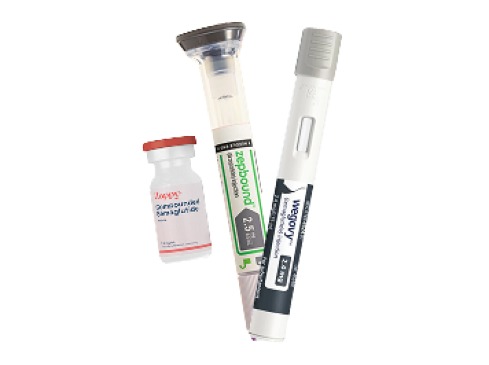Tirzepatide, known by the brand name Mounjaro, is an innovative medication that has gained attention for its effectiveness in managing type 2 diabetes and supporting weight loss. Like any medication, however, it comes with a range of possible side effects. In this article, we’ll cover everything you need to know about tirzepatide’s side effects, from common, mild symptoms to rare but serious complications. We’ll also discuss ways to manage these side effects and when to consult your healthcare provider.
If you’re new to tirzepatide or are considering switching to this medication, visit our detailed guide on the difference between tirzepatide and semaglutide to help you make an informed decision.
What is Tirzepatide?
Tirzepatide is a GLP-1 and GIP receptor agonist, which means it acts on two hormone receptors: glucagon-like peptide-1 (GLP-1) and glucose-dependent insulinotropic polypeptide (GIP). These receptors are involved in blood sugar regulation and appetite control, making tirzepatide a valuable medication for managing diabetes and supporting weight loss. By stimulating these receptors, tirzepatide helps lower blood sugar, promotes feelings of fullness, and slows down digestion.
If you’re interested in learning more about GLP-1 treatments and accessing them online, check out how to get GLP-1 online.
Common Side Effects of Tirzepatide
As with any medication, tirzepatide can cause side effects, especially as the body adjusts to the treatment. Here are some common side effects reported by patients:
a) Gastrointestinal Symptoms
The most frequently reported side effects are gastrointestinal in nature. These include:
- Nausea: Often mild and may subside as the body adjusts to the medication.
- Vomiting: More common at the beginning of treatment or after dose increases.
- Diarrhea: Can occur when starting tirzepatide and may be managed by staying hydrated.
- Constipation: Some patients report constipation, which can usually be managed with dietary adjustments.
These symptoms are similar to those experienced with other GLP-1 medications, such as semaglutide. For more on semaglutide’s mechanism, see how semaglutide works.
For general information on GLP-1 side effects, visit Mayo Clinic’s guide on GLP-1 receptor agonists.
b) Decreased Appetite
Tirzepatide is known for its ability to promote weight loss by reducing appetite. While decreased appetite is beneficial for weight management, it can also lead to a reduced interest in eating, which may feel uncomfortable for some. Patients using tirzepatide for weight loss can read more about weight management with GLP-1 medications.
Less Common Side Effects
In addition to common side effects, some patients experience less common but notable symptoms. While these are typically manageable, they should be discussed with your healthcare provider if they persist.
a) Headaches
Some patients report headaches, which can range from mild to moderate in intensity. Staying hydrated and ensuring you’re eating regularly can help reduce this side effect.
b) Fatigue
Fatigue is another possible side effect as your body adapts to tirzepatide. This is usually temporary but can be uncomfortable.
c) Injection Site Reactions
Tirzepatide is administered as a weekly injection, and some patients may experience redness, swelling, or itching at the injection site. This reaction is generally mild and goes away after a few hours.
For more information on medication-related fatigue, visit WebMD’s guide to managing medication side effects.
Serious Side Effects of Tirzepatide
While most side effects of tirzepatide are mild, there are some rare but serious side effects to be aware of. If you experience any of these symptoms, contact your healthcare provider immediately.
a) Pancreatitis
Pancreatitis, or inflammation of the pancreas, is a rare but serious side effect associated with GLP-1 receptor agonists like tirzepatide. Symptoms of pancreatitis include severe abdominal pain that radiates to the back, nausea, and vomiting. If you suspect pancreatitis, seek medical attention right away.
For additional information on pancreatitis and its symptoms, refer to the American Gastroenterological Association’s resource.
b) Thyroid Tumors
Studies on tirzepatide have raised concerns about the potential for thyroid tumors, including medullary thyroid carcinoma (MTC), although this risk is considered low. If you have a personal or family history of thyroid cancer or multiple endocrine neoplasia syndrome type 2 (MEN 2), it’s essential to inform your healthcare provider before starting tirzepatide.
c) Severe Allergic Reactions
While rare, some individuals may experience severe allergic reactions to tirzepatide. Symptoms include difficulty breathing, swelling of the face or throat, and hives. In such cases, seek immediate medical help.
For patients considering a switch to another medication, read our guide on switching from tirzepatide to semaglutide to understand your options.
Managing Tirzepatide Side Effects
If you experience mild to moderate side effects, here are some tips for managing them effectively:
a) Stay Hydrated
Nausea, vomiting, and diarrhea can lead to dehydration. Drink plenty of water throughout the day, especially if you’re experiencing gastrointestinal symptoms.
b) Adjust Your Diet
Eating smaller, more frequent meals can help reduce nausea and make you feel more comfortable. Avoiding rich, fatty, or spicy foods can also help manage digestive side effects.
c) Monitor Blood Sugar
As tirzepatide lowers blood sugar, monitoring your levels regularly can help you detect any potential dips and avoid hypoglycemia. If you’re unsure how to monitor your blood sugar effectively, consult your healthcare provider for guidance.
d) Follow Dosage Instructions Carefully
Taking tirzepatide as prescribed can help reduce side effects. Starting with a lower dose and gradually increasing it, as recommended by your healthcare provider, can allow your body to adjust more comfortably.
For more tips on managing medication side effects, check out CDC’s guidelines on safe medication use.
When to Consult Your Healthcare Provider
It’s essential to keep an open line of communication with your healthcare provider when using tirzepatide, especially if you experience any persistent or severe side effects. Contact your provider if you experience:
- Persistent gastrointestinal symptoms that impact daily life
- Symptoms of pancreatitis, such as severe abdominal pain
- Signs of an allergic reaction, such as difficulty breathing or swelling
- Any unusual changes in mood, energy levels, or other symptoms that concern you
If you’re wondering, “Does tirzepatide stop working over time?”, discussing your concerns with your provider can help determine the next best steps.
FAQs About Tirzepatide Side Effects
Q1: How long do side effects of tirzepatide last?
Most side effects, especially gastrointestinal symptoms, tend to improve as the body adjusts, typically within a few weeks. However, if symptoms persist, consult your healthcare provider.
Q2: Can I switch to another medication if tirzepatide’s side effects are too severe?
Yes, switching medications may be an option if side effects are intolerable. For those interested in exploring alternatives, read our blog on switching from tirzepatide to semaglutide.
Q3: Is there a way to reduce the risk of serious side effects?
To minimize the risk of serious side effects, follow your provider’s instructions closely, especially regarding dosage. Regular monitoring and early communication with your provider can also help detect any issues early.
For a broader comparison of tirzepatide with other similar medications, see the differences between tirzepatide and semaglutide.
Final Thoughts on Tirzepatide Side Effects
While tirzepatide offers substantial benefits for blood sugar control and weight loss, it’s essential to be aware of its potential side effects. Most side effects are mild and manageable, but there are rare, serious side effects that require attention. By understanding these side effects and working closely with your healthcare provider, you can make an informed decision about whether tirzepatide is the right medication for you.
For more insights on managing diabetes, weight loss, and related treatments, visit Zappy Health’s weight loss resource page. If you’re interested in other GLP-1 medications or need guidance on obtaining them, visit how to get GLP-1 online for comprehensive information on accessing these treatments.





